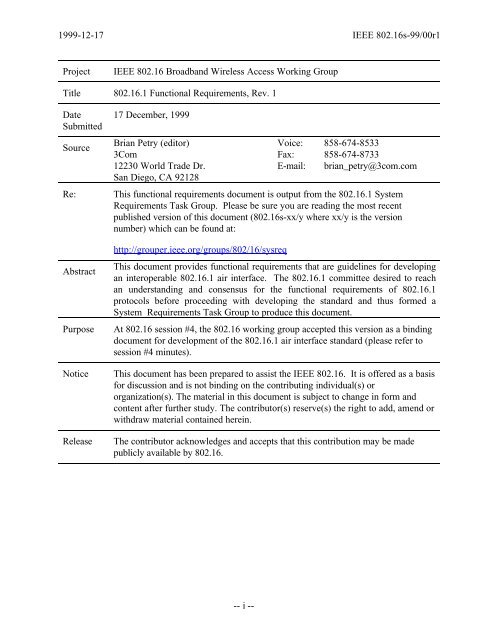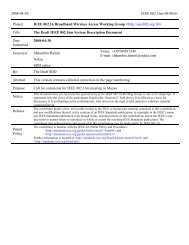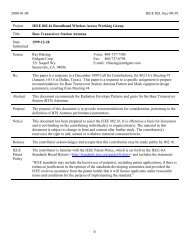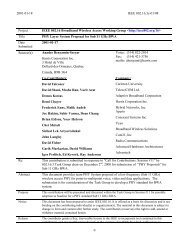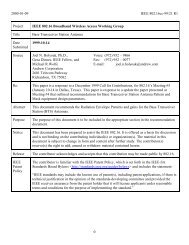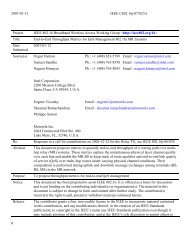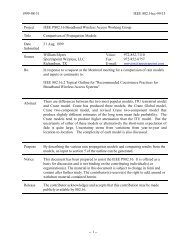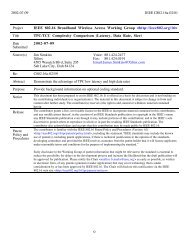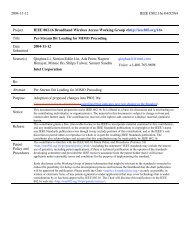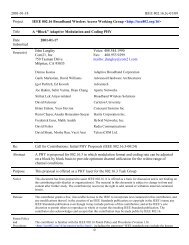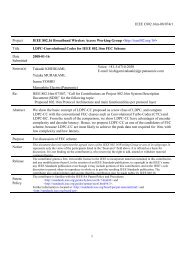802.16.1 Functional Requirements, Rev. 1 - LMSC, LAN/MAN ...
802.16.1 Functional Requirements, Rev. 1 - LMSC, LAN/MAN ...
802.16.1 Functional Requirements, Rev. 1 - LMSC, LAN/MAN ...
Create successful ePaper yourself
Turn your PDF publications into a flip-book with our unique Google optimized e-Paper software.
1999-12-17 IEEE 802.16s-99/00r1ProjectIEEE 802.16 Broadband Wireless Access Working GroupTitle <strong>802.16.1</strong> <strong>Functional</strong> <strong>Requirements</strong>, <strong>Rev</strong>. 1DateSubmittedSourceRe:AbstractPurposeNoticeRelease17 December, 1999Brian Petry (editor)3Com12230 World Trade Dr.San Diego, CA 92128Voice: 858-674-8533Fax: 858-674-8733E-mail: brian_petry@3com.comThis functional requirements document is output from the <strong>802.16.1</strong> System<strong>Requirements</strong> Task Group. Please be sure you are reading the most recentpublished version of this document (802.16s-xx/y where xx/y is the versionnumber) which can be found at:http://grouper.ieee.org/groups/802/16/sysreqThis document provides functional requirements that are guidelines for developingan interoperable <strong>802.16.1</strong> air interface. The <strong>802.16.1</strong> committee desired to reachan understanding and consensus for the functional requirements of <strong>802.16.1</strong>protocols before proceeding with developing the standard and thus formed aSystem <strong>Requirements</strong> Task Group to produce this document.At 802.16 session #4, the 802.16 working group accepted this version as a bindingdocument for development of the <strong>802.16.1</strong> air interface standard (please refer tosession #4 minutes).This document has been prepared to assist the IEEE 802.16. It is offered as a basisfor discussion and is not binding on the contributing individual(s) ororganization(s). The material in this document is subject to change in form andcontent after further study. The contributor(s) reserve(s) the right to add, amend orwithdraw material contained herein.The contributor acknowledges and accepts that this contribution may be madepublicly available by 802.16.-- i --
1999-12-17 IEEE 802.16s-99/00r1<strong>Rev</strong>ision HistoryDateSubmittedDocumentNumberAuthor<strong>Rev</strong>ision Notes1999-07-02 802.16s0-99/1 Brian Petry (editor) First Draft1999-07-14 802.16s0-99/2 Brian Petry (editor) Some changes approved by task group in session #11999-08-02 802.16s0-99/3 Brian Petry (editor) Marked-up with proposed changes: input to session #21999-08-09 802.16s0-99/4 Brian Petry (editor) Output from session #2: Changes approved by taskgroup; Unresolved Issues section added1999-10-21 802.16s0-99/5 Brian Petry (editor) Output from 2 ad hoc groups: terminology and QoS; andaccepted comments from on-line comment/resolution1999-09-17 through 1999-10-6.1999-11-11 802.16s-99/00r0 Brian Petry (editor) Preliminary release with comments resolved at session#4; Approved by the 802.16 working group as a bindingdocument for development of the <strong>802.16.1</strong> air interfacestandard.1999-12-17 802.16s-99/00r1 Brian Petry (editor) Editorial changes from previous version.-- ii --
1999-12-17 IEEE 802.16s-99/00r1AcknowledgementsThe content of this document was collected from 802.16 committee members over the period ofseveral months, based on both written contributions, verbal discussion in meetings and activity onthe email reflector. For the first draft, the editor took some liberty in discerning consensus anddetermining compromises on issues dealing with the scope of this document, the extent ofrequirements, and chosen terminology. While “processing” the contributions by members, theeditor did not usually use verbatim text, but attempted to extract the essence of requirements.Changes to subsequent versions of this document were made through a formal comment andchange-request submittal process. Many thanks go to the individuals who voiced their opinionsand strove for consensus in the IEEE 802.BWA Study Group meetings, the 802.16 System<strong>Requirements</strong> Task group meetings and on the email reflector. The editor also thanks thefollowing individuals who submitted written contributions (their documents may be found athttp://grouper.ieee.org/groups/802/16/sysreq):Arun ArunachalamRobert DuhamelGeorge FishelImed FriguiMarianna GoldhammerHossein IzadpanahDavid JarrettLeland LangstonJohn LiebetreuWillie LuScott MarinJames MollenauerWilliam MyersAsif RahmanMargarete RalstonGene RobinsonMichael StewartJung Yee-- iii --
1999-12-17 IEEE 802.16s-99/00r11234567891011121314151617181920212223242526272829303132333435363738394041424344451 IntroductionThis document provides functional requirements that are guidelines for developing aninteroperable <strong>802.16.1</strong> air interface. The <strong>802.16.1</strong> committee desired to reach an understandingand consensus for functional requirements before proceeding with developing standards for<strong>802.16.1</strong> MAC and PHY protocols and thus formed a System <strong>Requirements</strong> Task Group toproduce this document.Please note that this document provides guidelines for the 802.16 working group. Its purpose isto formulate and facilitate consensus on some general issues prior to plunging into MAC andPHY details. As such, the functional requirements are subject to change as the 802.16 workinggroup debates the issues, makes revisions, and approves this document as a basis for starting the“Interoperability Standard” [20].The <strong>Functional</strong> <strong>Requirements</strong> will not be published or sold by the IEEE. The requirements, withpossible future amendments, are binding to the future development of <strong>802.16.1</strong> air interfaceprotocols. This means that the forthcoming air interface standard MUST comply with thefunctional requirements.Throughout this document, the words that are used to define the significance of particularrequirements are capitalized. These words are:"MUST" or “SHALL” These words or the adjective "REQUIRED" means that the item is anabsolute requirement.."MUST NOT" This phrase means that the item is an absolute prohibition."SHOULD" This word or the adjective "RECOMMENDED" means that there may exist validreasons in particular circumstances to ignore this item, but the full implications should beunderstood and the case carefully weighed before choosing a different course."SHOULD NOT" This phrase means that there may exist valid reasons in particular circumstanceswhen the listed behavior is acceptable or even useful, but the full implications should beunderstood and the case carefully weighed before implementing any behavior described with thislabel."MAY" This word or the adjective "OPTIONAL" means that this item is truly optional. Oneimplementation may include the item because the target marketplace requires it or because itenhances the product, for example; another implementation may omit the same item.1.1 ScopeFor the purposes of this document, a “system” constitutes: an <strong>802.16.1</strong> MAC and PHYimplementation, in which at least one subscriber station communicates with a base station via apoint-to-multipoint (P-MP) radio air interface, the interfaces to external networks, and servicestransported by the MAC and PHY protocol layers. So, “functional requirements” describes theproperties of typical systems in terms of how they affect requirements of interoperable <strong>802.16.1</strong>MAC and PHY protocols. The functional requirements describe <strong>802.16.1</strong> systems and-1-
12345678910111213141516171819201999-12-17 IEEE 802.16s-99/00r1requirements in broad terms: what they are, but not how they work. The how part is left to theforthcoming <strong>802.16.1</strong> interoperability standard [20], which will describe in detail the interfacesand procedures of the MAC and PHY protocols.Since many BWA systems are conceivable, with many possible interconnections, inter-workingfunctions [17] and parameters, this document does not specify them all, but focuses on the bearerservices that an <strong>802.16.1</strong> system is required to transport. These bearer services have a directimpact on the requirements of the <strong>802.16.1</strong> MAC and PHY protocols. When the 802.16 workinggroup produces an interoperable air interface standard that meets these functional requirements,resulting <strong>802.16.1</strong> systems provide the services required to neatly interface into many conceivableBWA systems. See section 1.2.Other goals of this document are to formulate reference models and terminology for both networktopology and protocol stacks that help the 802.16 working group to discuss and develop theMAC and PHY protocols.The <strong>802.16.1</strong> air interface interoperability standard SHALL be part of a family of standards forlocal and metropolitan area networks. The <strong>802.16.1</strong> protocols relate to other 802 standards andto the OSI model as shown in Figure 1.21802.10 SECURITY802 OVERVIEW & ARCHITECTURE802.1 <strong>MAN</strong>AGEMENT802.2 LOGICAL LINK CONTROL802.[3,4,5,6...]PHYSICAL802.1 BRIDGING802.[3,4,5,6...]MEDIUMACCESS ...802.16MEDIUMACCESSOTHERUPPER LAYERS802.16PHYSICALDATALINKLAYERPHYSICALLAYER22232425262728293031Figure 1: Relationship between <strong>802.16.1</strong> and other Protocol Standards (the numbers inthe figure refer to IEEE standard numbers)This family of standards deals with the Physical and Data Link layers as defined by theInternational Organization for Standardization (ISO) Open Systems Interconnection BasicReference Model (ISO 7498: 1984). The access standards define several types of medium accesstechnologies and associated physical media, each appropriate for particular applications or systemobjectives. Other types are under investigation.The standards that define the technologies noted in the above diagram are as follows:-2-
123456789101112131415161718192021222324252627282930313233343536373839404142434445461999-12-17 IEEE 802.16s-99/00r1IEEE Std 802: Overview and Architecture. This standard provides an overview to the family ofIEEE 802 Standards. This document forms part of the 802.1 scope of work.ANSI/IEEE Std 802.1B [ISO/IEC 15802-2]: <strong>LAN</strong>/<strong>MAN</strong> Management. Defines an OpenSystems Interconnection (OSI) management-compatible architecture, environment for performingremote management.ANSI/IEEE Std 802.1D [ISO/IEC 10038]: MAC Bridging. Specifies an architecture andprotocol for the interconnection of IEEE 802 <strong>LAN</strong>s below the MAC service boundary.ANSI/IEEE Std 802.1E [ISO/IEC 15802-4]: System Load Protocol. Specifies a set of servicesand protocols for those aspects of management concerned with the loading of systems on IEEE802 <strong>LAN</strong>s.ANSI/IEEE Std 802.2 [ISO/IEC 8802-2]: Logical Link ControlANSI/IEEE Std 802.3 [ISO/IEC 8802-3]: CSMA/CD Access Method and Physical LayerSpecificationsANSI/IEEE Std 802.4 [ISO/IEC 8802-4]: Token Bus Access Method and Physical LayerSpecificationsIEEE Std 802.10: Interoperable <strong>LAN</strong>/<strong>MAN</strong> Security, Secure Data Exchange (SDE)1.2 Target MarketsThe target markets described in this section are not an exhaustive set, but serve as guidelines andexamples that suffice for meeting the broad applicability goals set forth by the air interface “FiveCriteria” [20a].A broadband wireless access (BWA) system based on <strong>802.16.1</strong> protocols is expected to addressmarkets similar to wired broadband access technologies such as:• Copper digital subscriber line (DSL) technologies• Digital cable TV hybrid fiber/coax (HFC) networks• Integrated Services Digital Network (ISDN)• Legacy TDM digital transmission systems (e.g., Full and Fractional T1, E1, ISDN-PRI etc.)• The services that such legacy systems carry: data, voice and audio/video [8].The initial target markets to be addressed by the <strong>802.16.1</strong> protocols in BWA networks are smallto large businesses, and multi-tenant dwellings such as high rise buildings. <strong>802.16.1</strong> protocols inBWA networks may address the target market for single-family residences.A key word in BWA is “access:” access to some other network such as the Internet, a privatenetwork, a telephony network, etc. An <strong>802.16.1</strong> access system generally provides access to anexternal network, and by itself is not intended to form an end-to-end communication system.<strong>802.16.1</strong> systems are fixed.-3-
123456789101112131415161718191999-12-17 IEEE 802.16s-99/00r12 <strong>802.16.1</strong> System ModelThis section presents a high level description of a system model to be used as a framework fordeveloping <strong>802.16.1</strong> protocol standards. The model describes some of the main features of an<strong>802.16.1</strong> system, and the terminology to be used by the 802.16 working group in the creation ofthe standards.As mentioned in section 1.1, an <strong>802.16.1</strong> “system” constitutes: an <strong>802.16.1</strong> MAC and PHYimplementation, in which at least one subscriber station communicates with a base station via aradio air interface (an <strong>802.16.1</strong> system), and services transported by the MAC and PHYprotocols. An <strong>802.16.1</strong> system employs point-to-multipoint (P-MP) radios operating in thevicinity of 30 GHz, but generally in the range from 10 GHz to 66 GHz, to connect a base stationto one or more subscriber stations [4][9]. Radio communications in the above range require lineof-sight(LOS) between a base station and subscriber station. LOS blocked by foliage alsocontributes heavily to signal attenuation. Figure 2-1 and Figure 2-2 [13] depict some typical<strong>802.16.1</strong> systems. <strong>802.16.1</strong> systems SHALL be multiple-cell frequency reuse systems. The rangeof <strong>802.16.1</strong> radios varies with transmit power, LOS blockage, availability requirement, andatmospheric conditions.202122Figure 2-1: System Showing a Base Station Mounted on a Tall Bulding-5-
1999-12-17 IEEE 802.16s-99/00r1123456789101112131415161718192021222324252627282930Figure 2-2: System Showing a Base Station Mounted on a TowerNote that, in concern for simple terminology, an <strong>802.16.1</strong> system consists of one base stationradio and one or more subscribers. Thus an <strong>802.16.1</strong> system also defines <strong>802.16.1</strong> base stationand subscriber station radios that communicate using the <strong>802.16.1</strong> MAC and PHY protocols.The base station radio SHOULD be P-MP, radiating its downstream signal with a shaped sectorantenna achieving broad azimuthal beam width to “cover” a prospective number of subscribers.Each subscriber station employs a highly directional radio pointed at the base station. Note thatwith this arrangement, direct radio communications between subscriber stations is not possible.Furthermore, the <strong>802.16.1</strong> system does not define radio communications between base stations.Since the base station radios are “sector oriented,” multiple base station radios will likely, inpractice, be co-located (subject to frequency re-use requirements), and even share physicalhardware.The frequency bands used by <strong>802.16.1</strong> systems vary among governed geographies [19].2.1 System Reference ModelFigure 2-3 shows the <strong>802.16.1</strong> system reference points, depicting the relevant elements between asubscriber network and the “core” network (the network to which <strong>802.16.1</strong> is providing access).The air interface MUST NOT preclude repeaters or reflectors to bypass obstructions and extendcell coverage. A greater system encompassing user terminals, base station interconnectionnetworks, network management facilities, etc. [1] may be envisaged, but the <strong>802.16.1</strong> protocolsfocus on the simplified model shown in the figure. Also not shown are the internal physicalcharacteristics of the base station and subscriber station: the concepts of “indoor” and “outdoor”units. The description of possible separation of base station and subscriber station into indoor andoutdoor units is beyond the scope of this document. One addition to this model to be consideredare security systems (see section 8). Two key interfaces “to the outside world” are shown in thefigure: the Base Station Network Interface (BNI) and the Subscriber Station Network Interface(SNI). A single SNI may support multiple subscriber networks: <strong>LAN</strong>s, Voice PBXs, etc. Andrecall from section 1.2 that the SNI may support multiple paying subscribers, such as within a-6-
1234567891011121999-12-17 IEEE 802.16s-99/00r1multi-tenant office building or dwelling. A base station interfaces to one or more core networksthrough one or more BNIs. For the purposes of <strong>802.16.1</strong>, the SNI and BNI are abstractconcepts. The details of these interfaces, which are sometimes called inter-working functions(IWFs), are beyond the scope of this document and are not specified by the forthcominginteroperability standard [20] [17]. Since many subscriber and core network technologies arepossible, many different IWFs are conceivable. The simplified reference model, serves to discussthe impact of core network technologies and bearer services (see section 3.1) on the requirementsof <strong>802.16.1</strong> protocols by drawing focus to the air interface and the immediate requirementsimposed by the surrounding networks. The standard (e.g., MAC/PHY protocols) SHALLdescribe common access protocol(s) and common modulation technique(s).SubscriberNetworkSNISSAirInterfaceBSBNICoreNetwork13SNI: SS Network InterfaceSS: Subscriber StationBS: Base StationBNI: BS Network InterfaceRepeater(OPTIONAL)14151617181920212223242526272829303132333435Figure 2-3: System Reference Points2.2 TopologySince all data traffic in a single cell of an <strong>802.16.1</strong> network MUST go through the base station,that station SHALL serve as a radio resource supervisor [10]. The subscriber stations mayrequest bandwidth to achieve QoS objectives (see section 6), but it may be convenient for thebase station to implement the “smarts” of bandwidth allocation.In the downstream direction, within a channel, the network topology is similar to a contentionlessbroadcast bus, since all transmissions are transmitted by the base station, and more than onesubscriber station could share a downstream channel. In the upstream direction, if subscriberstations share a channel, the topology is similar to a contention-oriented bus, <strong>802.16.1</strong> protocolsMUST provide the means to multiplex traffic from multiple subscriber stations in the downstreamdirection, and provide for a means to resolve contention and allocate bandwidth in the upstreamdirection.3 Supported ServicesThis section describes the bearer services that an <strong>802.16.1</strong> system at least SHOULD support(some services MUST be supported). First, typical target markets are described, then theparticular bearer services which an <strong>802.16.1</strong> system is expected to transport.It may be difficult to comprehend services the system supports without first understanding thesystem model. Please refer to section 2 if necessary.-7-
12345678910111213141516171819202122232425262728293031323334353637383940414243441999-12-17 IEEE 802.16s-99/00r13.1 Bearer ServicesThis section describes typical services, transported by an <strong>802.16.1</strong> system. In this document,bearer services refer to the services provided by the protocols that can appear in the layer sittingdirectly over the MAC layer. The meaning of bearer services in this document also includes thetypes of networks that are able to interface with <strong>802.16.1</strong>-based BWA networks. [12] [54].The MAC and PHY protocols may not have explicit support for each and every bearer service,since they SHOULD be handled as data streams in a generic fashion. But it is important toconsider all the bearer services for any particular requirements they may have and extract the“common denominators” that result as generic parameters of MAC and PHY protocols.3.1.1 Digital Audio/Video Multicast<strong>802.16.1</strong> protocols SHOULD efficiently transport digital audio/video streams to subscribers. Thisform of digital transport MAY bypass the MAC protocol layer. The streams flow in the directionof the infrastructure network to subscriber(s) only, and do not originate from subscribers. DigitalAudio/Video Multicast service is thus similar to digital video capabilities of digital broadcast cableTV, and digital satellite television service.3.1.2 Digital Telephony<strong>802.16.1</strong> systems SHOULD support supplying telephony “pipes” to subscribers in a way thateases the migration of legacy telephony equipment and public switched telephone network(PSTN) access technologies to <strong>802.16.1</strong> systems. <strong>802.16.1</strong> protocols MAY transport any layer inthe nationally- and internationally-defined digital telephony service hierarchies: SynchronousDigital Hierarchy (SDH) or Plesiochronous Digital Hierarchy (PDH) (please see the glossaryentries in appendix B).Note that many forms of digital telephony are possible:• Narrow band/Voice Frequency Telephony - POTS (supporting FAX services), Centrex, ISDNBRI• NxDSO Trunking - Fractional DS1/E1 to PBXs and/or data equipment, ISDN PRI• Full DS1/E1 - transparent mapping including all framing information• Voice Over IP, Voice Over Frame Relay, Voice and Telephony over ATM (VTOA), andsimilar services<strong>802.16.1</strong> systems and protocols MUST support the QoS requirements of these services, asdefined in Section 6.3.1.2.1 Telephony Service PropertiesThe relevant properties of telephony services are [12] [54]:• Bandwidth – in general, the codings used in these services require bandwidths in the range of64 Kbps or less per call (one exception is ISDN BRI service with both B channels and the Dchannel active, which uses 144 Kbps). There are also some subjective quality metrics for theclarity of the encoded speech signals, that can vary based on the quality of the services sold tothe end user (e.g., residential vs. business).-8-
12345678910111213141516171819202122232425262728293031323334353637383940411999-12-17 IEEE 802.16s-99/00r1• Low delay – as apparent to the end users, the amount of delay between a user speaking andanother user hearing the speech MUST be kept below a certain level to support two-wayconversation. Again, the specific amount of delay can vary based on the quality of the servicesold to the end user.• Timing - (Fractional) DS1/E1 services require timing to be delivered from the network to theend user's equipment, whether the timing is synchronous with the network (i.e., based on theserving network's clock) or asynchronous with the network (based on a clock other than theserving network's clock).BWA protocols MUST support efficient transport of encoded voice data in terms of bandwidth,reliability and delay. Other properties are managed by digital signaling protocols (see section3.1.2.2).3.1.2.2 Signaling Systems and ProtocolsTelephony and video conferencing signaling protocols may place specific requirements on<strong>802.16.1</strong> protocols. Some relevant telephony signaling protocols are: Bellcore TR-008, V5.X,Q.931, Q.2931, H.225, H.245, H.323, MGCP, Bellcore GR-303, , MFC R2, E&M, Q.sig, IETFSIP, etc. [12] [17] [61] [editor’s note: protocol references not cited].In digital telephony hierarchies, periodic bits in the time-division-multiplexed data stream,sometimes “robbed” from encoded voice streams, are used to transport signaling andtroubleshooting information [12]. Other signaling protocols (such as those used in ISDN and B-ISDN/ATM) are message-oriented and do not utilize periodic bits in a TDM data stream. The<strong>802.16.1</strong> protocols MUST meet the transport requirements of such telephony signaling, whetherTDM- or message-oriented.3.1.3 ATM Cell Relay ServiceATM standards define a rich set of quality of service (QoS) guarantees for various servicecategories [8].<strong>802.16.1</strong> protocols SHOULD be defined such that an <strong>802.16.1</strong> system can efficiently transportATM cell relay service and preserve its QoS features (see section 6).Also note that, since ATM cell relay service is circuit-based, it employs message-based signalingprotocols (Q.2931) to establish, maintain and tear down switched virtual circuits as well as signalQoS-based services and perform network management. <strong>802.16.1</strong> protocols may need to becognizant of such ATM signaling to enable an <strong>802.16.1</strong> system to preserve QoS (see also section3.1.2.2).<strong>802.16.1</strong> SHOULD provide a means to utilize ATM addresses such as ITU-T E.164 [74]. Forinstance, <strong>802.16.1</strong> MAY provide a direct ATM addressing mode for <strong>802.16.1</strong> nodes, or MAYprovide a means to translate ATM addresses to 802 addresses [10].-9-
12345678910111213141516171819202122232425262728291999-12-17 IEEE 802.16s-99/00r1“The LLC Sublayer (sublayer of layer 2) describes three types of operation for data communication betweenservice access points: unacknowledged connectionless (type 1), connection-oriented (type 2), and acknowledgedconnectionless (type 3).With type 1 operation, information frames are exchanged between LLC entities without the need for the priorestablishment of a logical link between peers. These LLC frames are not acknowledged, nor are there any flowcontrol or error recovery procedures.With type 2 operation, a logical link is established between pairs of LLC entities prior to any exchange ofinformation frames. In the data transfer phase of operation, information frames are transmitted and delivered insequence. Error recovery and flow control are provided.With type 3 operation, information frames are exchanged between LLC entities without the need for the priorestablishment of a logical link between peers. However, the frames are acknowledged to allow error recovery andproper ordering. Further, type 3 operation allows one station to poll another for data.”“The MAC Sublayer performs access control functions for the shared medium in support of the LLC Sublayer. Fordifferent applications, different MAC options may be required. The MAC Sublayer performs the addressing andrecognition of frames in support of LLC. MAC also performs other functions, such as frame check sequencegeneration and checking, and LLC protocol data unit (PDU) delimiting.”“The Physical Layer provides the capability of transmitting and receiving bits between Physical Layer Entities. Apair of Physical Layer Entities identifies the peer-to-peer unit exchange of bits between to MAC users. ThePhysical Layer provides the capability of transmitting and receiving modulated signals assigned to specificfrequency channels, in the case of broadband, or to a single-channel band, in the case of baseband.”The <strong>802.16.1</strong> protocol stack reference diagram is shown in Figure 4-1. In addition to the LLC,MAC and PHY layers suggested by the generic 802 architectures [21] [22] [23], <strong>802.16.1</strong>protocols transport other categories of “upper protocols” that correspond to the requirements ofthe bearer services described in section 3.1.APPLICATIONPRESENTATIONATM LLC STMSESSIONTRANSPORT802.16MACATM LLC STM(convergence layer)DigitalAudio/VideoMACNETWORK30DATA LINKPHYSICAL802.16PHYMAC TC(convergence layer)PMDDAV TC31Figure 4-1: Protocol Stack Reference Model-11-
12345678910111213141516171819202122232425262728293031323334353637383940414243444546471999-12-17 IEEE 802.16s-99/00r1This protocol stack reference model is intended to help develop terminology, and possiblyprotocol architecture. Each of the “special” protocols above the MAC and PHY are given“convergence sub-layers.”. The convergence sub-layers [2] [17] may be necessary to:• Encapsulate PDU framing of upper layers into the native <strong>802.16.1</strong> MAC/PHY PDUs. [17]• Map an upper layer’s addresses into <strong>802.16.1</strong> addresses• Translate upper layer CoS/QoS parameters into native <strong>802.16.1</strong> MAC constructs• Adapt the asynchronous, synchronous or isochronous data pattern of the upper layer into theequivalent MAC service• Reduce the need for complex inter-working functions (IWFs) [17]For instance, in the ATM world a Transmission Convergence (TC) layer is defined for each linktype that carries ATM cells. The purpose of this layer is to delimit cells using the particular linktechnology, and to signal idle time, or insert idle ATM cells on the link. <strong>802.16.1</strong> borrows thisterminology to accommodate “special” requirements of the multiple upper layer protocols.Another assumption made in the diagram is that digital audio/video (DAV) service bypasses theMAC protocol layer and accesses the PHY layer directly. This assumption is made because theDAV multicast bearer service (see section 3.1.1) is transmitted in the downstream direction only,and does not require the main service of the MAC: channel contention (access control).The central purpose of the MAC protocol layer in <strong>802.16.1</strong> is sharing of radio channel resources.The MAC protocol defines how and when a base station or subscriber station may initiatetransmission on the channel. Since key layers above the MAC, such as ATM and STM, requireservice guarantees, the MAC protocol MUST define interfaces and procedures to provideguaranteed service to the upper layers. In the downstream direction, since only one base station ispresent, and controls its own transmission, the MAC protocol is simple. But in the upstreamdirection, if one radio channel is allocated to more than one subscriber station, the MAC protocolMUST efficiently resolve contention and bandwidth allocation. Note that the function of theMAC layer is not to provide error correction by retransmission, or automatic repeat request(ARQ). In the 802 model, those functions if necessary, are provided by the LLC layerThe PHY layer is similarly subdivided between a convergence layer and a physical mediumdependent(PMD) layer. The PMD is the “main” part of the PHY. Like the MAC convergencelayers, the PHY convergence layers adapt/map the “special” needs of the MAC and DAV servicesto generic PMD services. For instance, to best support DAV services, the PHY MAY provideTDM-based encapsulation of DAV streams in TDM MPEG-II frames [14].Further details, and finalization of the protocol reference model, SHALL be worked out by the <strong>802.16.1</strong> MAC andPHY task groups while developing the air interface interoperability standard.5 Performance and CapacityThis section addresses some issues regarding <strong>802.16.1</strong> system performance and capacity.Specifying protocols such that an <strong>802.16.1</strong> system can maintain a specified/mandated performancelevel in the face of rapidly changing channel characteristics (e.g., due to rain) will be a difficultproblem for the <strong>802.16.1</strong> working group. This section specifies the target performance levels.Given the target performance levels, planning and provisioning an <strong>802.16.1</strong> system instance is alsoa difficult problem. The <strong>802.16.1</strong> system capacity at the target performance levels for all-12-
1234567891011121314151617181920212223242526272829303132333435363738394041421999-12-17 IEEE 802.16s-99/00r1subscribers, given geographically local LOS obstruction and atmospheric conditions will also bedifficult. This section also outlines some of the issues for <strong>802.16.1</strong> capacity planning.Note that ITU-R (WP 9A) has presented several questions regarding the need for performanceobjectives for fixed wireless access radio systems. [16]5.1 ScalabilityThe <strong>802.16.1</strong> protocols SHOULD allow for different “scales” of capacity and performance for<strong>802.16.1</strong> system instances.5.2 Delivered Bandwidth<strong>802.16.1</strong> protocols SHALL be optimized to provide the peak capacity from 2 to 155 Mbps to asubscriber station sufficiently close to the base station. The <strong>802.16.1</strong> MAC protocol SHOULDallow the upper range of delivered bandwidth to scale beyond 155 Mbps. However, <strong>802.16.1</strong>protocols SHALL not preclude the ability of an <strong>802.16.1</strong> system to deliver less than 2 Mbps peakper-user capacity.5.3 Flexible Asymmetry<strong>802.16.1</strong> protocols SHOULD allow for flexibility between delivered upstream and downstreambandwidth and CoS/QoS. Some target markets utilize naturally asymmetrical bandwidth, such asfor generic Internet access where most of the bandwidth is consumed in the downstreamdirection. Some markets utilize asymmetrical bandwidth, using more in the upstream direction,such as a video multicast from a corporate or distance-learning source. Other markets andapplications require symmetrical bandwidth, such as telephony and video conferencing [17].A high degree of flexibility may be achieved by utilizing the MAC protocol to arbitrate channelbandwidth in either direction, upstream or downstream.5.4 Radio Link AvailabilityAn <strong>802.16.1</strong> system SHOULD be available to transport all services at better than their requiredmaximum error rates (see section 5.5) from about 99.9 to 99.999% of the time [2, 11] , assumingthat the system and radios receive adequate power 100% of the time and not counting equipmentavailability. Note that 99.999% availability amounts to approximately 5 minutes of outage ayear. The <strong>802.16.1</strong> specifications SHALL NOT preclude the ability of the radio link to beengineered for different link availabilities, based on the preference of the system operator.A period of unavailable time begins at the onset of ten consecutive SES events based on thefollowing definitions (cite G.826).• Severely Errored Second (SES) is defined as a one-second period which contains 30% erroredblocks.• Errored Block (EB): A block is defined as a set of consecutive bits associated with the path.Consecutive bits may not be contiguous in time. A block is typified as data block containingan error detection code for service performance monitoring. An errored block is a block inwhich one or more bits are in error.-13-
123456789101112131415161718192021222324252627282930313233343536373839404142431999-12-17 IEEE 802.16s-99/00r1It is expected that the highest contributor to <strong>802.16.1</strong> system outage will be excessive attenuationdue to atmospheric conditions (e.g., rain rate, droplet size and other factors) [50] [51] [52] [53][72]. <strong>802.16.1</strong> MAC and PHY protocols MUST accommodate atmospheric conditions, perhapsconsuming more radio bandwidth and/or requiring smaller radio propagation distance (radius) tomeet the availability requirements. Since statistical atmospheric conditions vary widely ingeography, the <strong>802.16.1</strong> protocols MUST be flexible in consumed radio bandwidth (spectralefficiency), cell radius, and transmit power to accommodate a rain allowance that varies withgeography [11]. Bandwidth and cell radius are critical components of system/cell capacityplanning (also see section 5.7).<strong>802.16.1</strong> MAC and PHY protocols SHOULD specify functions and procedures to adjust power,modulation, or other parameters to accommodate rapid changes in channel characteristics due toatmospheric conditions.5.5 Error PerformanceThe error rate, after application of the appropriate error correction mechanism (e.g., FEC),delivered by the PHY layer to the MAC layer SHALL meet IEEE 802 functional requirements:The bit error ratio (BER) is 10E-9. Note that this BER applies to a BWA system which is onlyone component of a network’s end-to-end BER. Additionally, each block of data delivered by thePHY to the MAC MUST allow for detection of errors by the MAC (e.g., by CRC) with 1, 2 or 3errored bits (a Hamming Distance of 4) [7]. Note that the size of the data block is TBD.5.6 DelayVariation of delay, or jitter, is important to consider. For example, a high variation of delay canseverely impact telephony services. But generic Internet access can tolerate a high degree ofdelay variation.The end-to-end delay is a subjective metric and depends on an entire application-specific networkencompassing all 7 layers of the OSI model. In a telephony network, for example, the maximumacceptable end-to-end delay for the longest path is RECOMMENDED to be less than 300ms [15][17] [75].The budget for <strong>802.16.1</strong> system transit delay and access delay MUST be derived. [15] [17]. TheMAC layer may have different requirements for each direction, upstream and downstream. In theupstream direction, time MUST be budgeted for requesting bandwidth and contending amongnodes. The budget for <strong>802.16.1</strong> transit delay is suggested to be less than 19.5 ms [15] for“stringent QoS” services.ITU I.356 [73] recommends end-to-end variation (jitter) for “stringent QoS class” to be less than3 ms. Multimedia videoconferencing requires delay variation to be less than 200 ms end-to-end toallow for reasonable synchronization of audio and video streams [17]. It is suggested that thebudget for <strong>802.16.1</strong> systems be 1.5ms [15] for “stringent QoS” services.Please refer to section 6.2, descriptions of QoS parameters.-14-
1234567891011121314151617181920212223242526272829303132333435363738394041424344451999-12-17 IEEE 802.16s-99/00r15.7 Capacity Issues<strong>802.16.1</strong> system capacity requirement is defined as the product of the number of subscribers, theirpeak bandwidth requirements and load factor based on quality of service guarantees. Thedelivered capacity can vary depending on attenuation due to atmospheric conditions, LOSblockage, transmit power, etc. In a given <strong>802.16.1</strong> system instance, capacity MUST be carefullyplanned to ensure that subscribers’ quality of service guarantees and minimum error rates are met.Given the atmospheric conditions statistics in a geographic area, and the development of achannel link budget [11], the following parameters of an <strong>802.16.1</strong> system SHOULD be addressedby the MAC and PHY protocols [11]:• Radio range (shaped sector radius)• Width of the sector• Upstream/downstream channels’ data rates• Allocation of prospective subscriber data rate to channels. Note: the MAC and PHYstandards MAY allow subscribers to hop between channels• Types of modulationThe MAC and PHY protocols MUST accommodate channel capacity issues and changes inchannel capacity to meet contracted service levels with customers. For example, flexiblemodulation types, power level adjustment, and bandwidth reservation schemes MAY beemployed. Also, as subscribers are added to <strong>802.16.1</strong> systems, the protocols MUSTaccommodate them in an automated fashion.The time-variant impairments, rain fade and multi-path interference, are expected to be the mostsignificant contributors to channel impairments and complexity in cell capacity planning [7] [37][38] [39] [40] [11] [50] [51] [52] [53]. Common metrics, such as dispersive fade margin (DFM)[7] for frequency-selective fading environments, may be employed to compare the performance of<strong>802.16.1</strong> equipment (e.g., radios and modems).6 Class of Service and Quality of ServiceThis section describes the classes of service and quality of service for <strong>802.16.1</strong> systems.Terminology is borrowed from the ATM Forum and Internet Engineering Task Force (IETF)worlds.<strong>802.16.1</strong> protocols MUST support classes of service (CoS) with various quality of service (QoS)guarantees to support the bearer services (see section 8) that an <strong>802.16.1</strong> system MUSTtransport. Each bearer service defines guarantees that they “expect” to be preserved by an<strong>802.16.1</strong> system. Thus, <strong>802.16.1</strong> protocol standards MUST define interfaces and procedures thataccommodate the needs of the bearer services with respect to allocation of prioritization ofbandwidth. Additionally, <strong>802.16.1</strong> protocols MUST provide the means to enforce QoS contractsand Service Level Agreements [2] (see section 7.1). Error! Reference source not found. Table 1provides a summary of the QoS requirements that the PHY and MAC SHALL provide. Note thatdelay in the table refers to the transmission delay from the MAC input from the upper layer at thetransmit station to the MAC output to the upper layer the receiving station for informationtransmission. It does not include setup time, link acquisition, etc.-15-
123456789101112131415161999-12-17 IEEE 802.16s-99/00r1The <strong>802.16.1</strong> protocols MUST be capable of dedicating constant-rate, provisioned, bandwidth forbearer services such as SDH/PDH. For instance, the MAC layer MAY employ TDM allocationof bandwidth within a channel for these services. TDM bandwidth allocation may be performeddynamically to allow for both 1) turning up fixed-bandwidth Permanent Virtual Circuits (PVCs)and 2) for dynamically changing bandwidth of a virtual circuit once it has been established.For QoS-based, connectionless, but not circuit-based, bearer services, the <strong>802.16.1</strong> protocolsMUST support bandwidth negotiation “on-demand” [9]. For instance, the MAC protocol MAYallocate bursts of time slots to bearer services that require changes in bandwidth allocation. Suchallocation is thus performed in a semi-stateless manner. A connection-oriented bearer service mayrequire “state” information to be maintained for the life of a connection. But the <strong>802.16.1</strong> MAClayer interface MAY provide a connection-less service interface that requires a higher-layer“adaptation” to maintain the “state” of a connection and periodically allocate bandwidth. Forinstance, the MAC may need to maintain “state” information about a QoS data flow only for theduration of an allocation.Bearer ServiceHigh Quality Narrowband/VoiceFrequency Telephony (VocoderMOS ≥ 4.0)Lower Quality Narrowband/VoiceFrequency Telephony (VocoderMOS < 4.0)Table 1: Services and QoS <strong>Requirements</strong>MAC Payload MaximumRate RatioCircuit-Based32 kbps – 64 kbps 10 -6BER6 kbps – 16 kbps 10 -4Trunking
1999-12-17 IEEE 802.16s-99/00r1ATM Cell Relay – other
123456789101112131415161718192021222324252627282930313233343536373839404142431999-12-17 IEEE 802.16s-99/00r16.3 Bearer Service QoS MappingsThe classes of service and QoS parameters of bearer services SHALL be translated into acommon set of parameters defined by <strong>802.16.1</strong>. A network node that serves as an inter-workingfunction (IWF) between a QoS-capable <strong>LAN</strong> or WAN and an <strong>802.16.1</strong> system MUST participatein signaling protocols to set up QoS parameters for connection-oriented services.For example, if an ATM network is to be transported over an <strong>802.16.1</strong> system, ATM switchedvirtual circuits negotiate QoS parameters for the circuit. The IWF MUST participate in the ATMsignaling protocol that sets up the circuit. It also MUST utilize <strong>802.16.1</strong> interface primitives(e.g., MAC layer user interface primitives) to request QoS.Similarly, a QoS-based IP network may employ the Resource Reservation Protocol (RSVP) [70]to “signal” the allocation of resources along a routed IP path. If <strong>802.16.1</strong> is to be a “link” in theIP network, an IWF MUST interface with <strong>802.16.1</strong> to negotiate resource allocation.The specification of how IWFs operate is outside the scope of this document and the forthcoming<strong>802.16.1</strong> interoperable air interface standard [20] [20a]. However, the QoS parameters for<strong>802.16.1</strong> MUST be chosen and interface primitives defined that allow for bearer services’ IWFsto negotiate QoS “through” an <strong>802.16.1</strong> system.The basic mechanism available within <strong>802.16.1</strong> systems for supporting QoS requirements is toallocate bandwidth to various services. <strong>802.16.1</strong> protocols SHOULD include a mechanism thatcan support dynamically-variable-bandwidth channels and paths (such as those defined for ATMand IP environments).7 ManagementAs outlined in IEEE Std 802-1990 [21], The LLC Sublayer, MAC Sublayer and Physical Layerstandards also include a management component that specifies managed objects and aspects of theprotocol machine that provide the management view of managed resources. The aspect ofmanagement considered are (FCAPS):• Fault management• Configuration management• Accounting management• Performance management (see also 5)• Security (see also section 8)The 802 standards define a framework for <strong>LAN</strong>/<strong>MAN</strong> management in ISO/IEC 15802-2:1995(E) [24]. The framework contains guidelines for managed objects, management protocol,and the relationship to ITU management protocols (CMIP/CMIS).7.1 Service Level AgreementsThe <strong>802.16.1</strong> protocols MUST permit operators to enforce service level agreements (SLAs) withsubscribers by restricting access to the air link, discarding data, dynamically controlling bandwidthavailable to a user or other appropriate means [3]. The <strong>802.16.1</strong> protocols MUST also permit-18-
123456789101112131415161718192021222324252627282930313233343536373839401999-12-17 IEEE 802.16s-99/00r1subscribers to monitor performance service levels of the <strong>802.16.1</strong> services being provided at thedelivery point.7.2 Malfunctioning Subscriber Station or Base StationThe operator MUST have means to shut down a subscriber station if necessary, remote from thesubscriber station, in the face of a malfunction. The operator also MUST have the means to shutdown a base station remotely. The <strong>802.16.1</strong> protocols SHOULD support a function thatautomatically shuts down transmission from a subscriber station or base station in case ofmalfunction (e.g., power limits exceeded).7.3 Accounting and AuditingThe <strong>802.16.1</strong> system management framework, architecture, protocols and managed objectsMUST allow for operators to effectively administer accounting and auditing. An operator MUSTbe able to account for time- and bandwidth-utilization and the various QoS parameters for eachsubscriber. Also recall from Section 1.2 that a single subscriber station can interface to multiplesubscribers that an operator could bill separately.8 SecurityThe <strong>802.16.1</strong> system SHALL enforce security procedures described in this section.The security system chosen by <strong>802.16.1</strong> SHALL be added to the protocol stack (Figure 4-1) andreference points (Figure 2-3) to include security protocols, and “database” servers forauthentication, authorization, key management, etc. [29] [30]8.1 AuthenticationThere are two levels of authentication for an <strong>802.16.1</strong> system. The first level of authentication iswhen the subscriber station authenticates itself with the base station at the subscriber station'snetwork entry. This initial authentication MUST be very strong in order to prevent “enemy”subscriber station from entering the network or an “enemy” base station from emulating a realbase station. Once the initial authentication at this level is complete, future authentication at thislevel can be a little more relaxed. This level of authentication MUST be supported by the<strong>802.16.1</strong> MAC layer.The second level of authentication is between the subscriber and the BWA system. This may ormay not be the responsibility of the <strong>802.16.1</strong> protocols. It MAY be handled by higher layerprotocols.An additional level of authentication may exist between the other two. This additional layer is theauthentication of the subscriber with the subscriber station. This is beyond the scope of the<strong>802.16.1</strong> protocols.The authentication mechanisms MUST be secure so that an “enemy” subscriber station is not ableto gain access to an <strong>802.16.1</strong> system, or to the core network beyond. Passwords and secretsMUST NOT be passed “in the clear” through the air interface.-19-
123456789101112131415161718192021222324251999-12-17 IEEE 802.16s-99/00r18.2 AuthorizationAuthorization is a security process that determines what services an authenticated subscriber ispermitted to invoke. Each subscriber has a set of credentials that describe what the subscriber is“allowed” to do. The <strong>802.16.1</strong> standard SHALL identify a standard set of credentials and allowfor vendors to extend the defined credentials with non-standard credentials. Some possiblecredentials are:• Permission to access the <strong>802.16.1</strong> system• Permission to request up to a defined QoS profile (bandwidth, delay, etc.)• Permission to operate certain bearer services (ATM, IP, Remote Bridging, DigitalAudio/Video, etc.)Subscriber authorization requests and responses MUST be transacted securely.8.3 PrivacyPrivacy is a security concept that protects transmitted data from being intercepted and understoodby third parties (e.g., an “enemy” subscriber station, base station or passively “listening” radio).Wire-equivalent privacy (WEP) [10] and shared private key [10] privacy have been suggested asminimum required privacy levels for <strong>802.16.1</strong> systems.<strong>802.16.1</strong> standards SHOULD allow a strong cryptographic algorithm to be employed that isinternationally applicable. Facilities SHOULD also be defined in the protocol for the use ofalternate cryptographic algorithms that can be used in certain localities and that can replacealgorithms as they are obsoleted or “legalized” for international use.-20-
1234567891011121314151617181920211999-12-17 IEEE 802.16s-99/00r19 802 ConformanceAs mentioned in some earlier sections of this document, <strong>802.16.1</strong> SHOULD strive to fit into the802 system model. Some particulars with the 802 model (see IEEE Standards for Local andMetropolitan Area Networks: Overview and Architecture (IEEE Std 802-1990) [21]) are:• The <strong>802.16.1</strong> MAC supports 802 “universal” 48 bit addresses.• An <strong>802.16.1</strong> system supports MAC multicast. Note that <strong>802.16.1</strong> protocols support multicastin the downstream direction only, not upstream.• The <strong>802.16.1</strong> protocols support 802.1 bridging services and protocols, including support ofthe 802.1q virtual <strong>LAN</strong> tag and 802.1D priority ID [25] [26] [28].• The <strong>802.16.1</strong> protocols support encapsulation of 802.2 (LLC) [67] by the MAC protocol .• Conform to the 802 conventions and structures for “interface primitives:” logical structuresthat are passed between protocol layers to invoke processes and transact data.• Address the 802 system management guidelines (see section 7) [27].• Provide a MAC service interface that complies to 802 conventions [22].-21-
1234567891011121314151617181999-12-17 IEEE 802.16s-99/00r1A <strong>Requirements</strong> SummaryAppendixThis section contains tabular summaries or requirements found in the text of this document.<strong>Requirements</strong> are separated into three categories: required, recommended and optional.Each requirement is numbered for easy reference. Future revisions of this document will keep therequirement reference numbers intact such that the number for a requirement will not change fromrevision to revision.To better discern the meaning and intent of a requirement, please refer to the text.Editor’s note: As additional information for 802.16 task groups, the areas of the standard which arequirement is most likely to affect are also given: MAC, PHY, Management (MGMT), andSecurity (SEC). This additional information, selected by the editor, is meant as a guideline only:task groups should examine the impact of all requirements.A.1 MandatoryIt is mandatory that the <strong>802.16.1</strong> standard support or specify the items in Table 2.Table 2: Mandatory <strong>Requirements</strong># Section Requirement AffectsMostlyM1 1 The forthcoming air interface standard MUST comply with thesystem requirements.M2 1.1 The <strong>802.16.1</strong> air interface interoperability standard SHALL be partof a family of standards for local and metropolitan area networks.M3 2 <strong>802.16.1</strong> systems SHALL be multiple-cell frequency reuse systems. MACPHYM4 2.1 The air interface MUST NOT preclude repeaters or reflectors tobypass obstructions and extend cell coverage.M5 2.1 The standard (e.g., MAC/PHY protocols) SHALL describe commonaccess protocol(s) and common modulation technique(s).M6 2.2 All data traffic in a single cell of an <strong>802.16.1</strong> network MUST gothrough the base station.AllAllPHYMACPHYMACM7 2.2 The base station SHALL serve as a radio resource supervisor. MACM8 2.2 <strong>802.16.1</strong> protocols MUST provide the means to multiplex trafficfrom multiple subscriber stations in the downstream direction, andprovide for a means to resolve contention and allocate bandwidth inthe upstream direction.M9 3.1.2 <strong>802.16.1</strong> systems and protocols MUST support the QoSrequirements of the services:MACMAC-22-
1999-12-17 IEEE 802.16s-99/00r1• Narrowband/Voice Frequency Telephony - POTS (supportingFAX services), Centrex, ISDN BRI 35• NxDSO Trunking - Fractional DS1/E1 to PBXs and/or dataequipment, ISDN PRI 36• Full DS1/E1 - transparent mapping including all framinginformation• Voice Over IP, Voice Over Frame Relay, Voice and Telephonyover ATM (VToA), and similar servicesM10 3.1.2.1 The amount of delay between a user speaking and another userhearing the speech MUST be kept below a certain level to supporttwo-way conversation.M11 3.1.2.1 BWA protocols MUST support efficient transport of encoded voicedata in terms of bandwidth, reliability and delay.M12 3.1.2.2 MUST meet the transport requirements of telephony signaling,whether TDM- or message-oriented.M13 3.1.4 802.16 MUST directly transport variable length IP datagramsefficiently.MACPHYMACPHYMACMACM14 3.1.4 Both IP version 4 and 6 MUST be supported. MACM15 3.1.4 The <strong>802.16.1</strong> IP service MUST provide support for real-time andnon-real-time services.M16 4 The MAC protocol MUST define interfaces and procedures toprovide guaranteed service to the upper layers.M17 4 The MAC protocol MUST efficiently resolve contention andbandwidth allocation.M18 4 Further details, and finalization of the protocol reference model,SHALL be worked out by the <strong>802.16.1</strong> MAC and PHY task groupswhile developing the air interface interoperability standard.M19 5.2 <strong>802.16.1</strong> protocols SHALL be optimized to provide the peakcapacity from 2 to 155 Mbps to a subscriber station sufficiently closeto the base station.M20 5.2 <strong>802.16.1</strong> protocols SHALL NOT preclude the ability of an <strong>802.16.1</strong>system to deliver less than 2 Mbps peak per-user capacity.M21 5.4 The <strong>802.16.1</strong> specifications SHALL NOT preclude the ability of theradio link to be engineered for different link availabilities, based onthe preference of the system operator.M22 5.4 <strong>802.16.1</strong> MAC and PHY protocols MUST accommodateatmospheric conditions, perhaps consuming more radio bandwidthand/or requiring smaller radio propagation distance (radius) to meetthe availability requirements.MACMACMACAllMACPHYMACPHYPHYMACPHYMGMT-23-
1999-12-17 IEEE 802.16s-99/00r1M23 5.4 Since statistical atmospheric conditions vary widely in geography, the<strong>802.16.1</strong> protocols MUST be flexible in consumed radio bandwidth(spectral efficiency), cell radius, and transmit power to accommodatea rain allowance that varies with geography.M24 5.5 The error rate, after application of the appropriate error correctionmechanism (e.g., FEC), delivered by the PHY layer to the MAClayer SHALL meet IEEE 802 functional requirements: The bit errorrate (BER) is 10E-9.M25 5.5 Each block of data delivered by the PHY to the MAC layer MUSTallow for detection of errors by the MAC (e.g., by CRC) with 1, 2 or3 errored bits (a Hamming Distance of 4).M26 5.6 The budget for the <strong>802.16.1</strong> system transit delay and access delayMUST be derived. The MAC layer may have different requirementsfor each direction, upstream and downstream.M27 5.6 In the upstream direction, time MUST be budgeted for requestingbandwidth and contending among nodes.M28 5.7 In a given <strong>802.16.1</strong> system instance, capacity MUST be carefullyplanned to ensure that subscribers’ quality of service guarantees andmaximum error rates are met.M29 5.7 The MAC and PHY protocols MUST accommodate channel capacityissues and changes in channel capacity to meet contracted servicelevels with customers.M30 5.7 As subscribers are added to <strong>802.16.1</strong> systems, the protocols MUSTaccommodate them in an automated fashion.M31 6 <strong>802.16.1</strong> protocols MUST support classes of service (CoS) withvarious quality of service (QoS) guarantees to support the bearerservices that an <strong>802.16.1</strong> system MUST transport.M32 6 <strong>802.16.1</strong> protocol standards MUST define interfaces and proceduresthat accommodate the needs of the bearer services with respect toallocation of prioritization of bandwidth.M33 6 <strong>802.16.1</strong> protocols MUST provide the means to enforce QoScontracts and Service Level Agreements.M34 6 The <strong>802.16.1</strong> protocols MUST be capable of dedicating constantrate,provisioned, bandwidth for bearer services such as SDH/PDH.M35 6 For QoS-based, connectionless, but not circuit-based, bearerservices, the <strong>802.16.1</strong> protocols MUST support bandwidthnegotiation “on-demand.”M36 6 Table 1 provides a summary of the QoS requirements that the PHYand MAC SHALL provide.M37 6.2 <strong>802.16.1</strong> protocols SHALL define a set of parameters that preservethe intent of QoS parameters for both ATM- and IP-based services.-24-MACPHYMGMTMACPHYPHYMACPHYMACMGMTMACPHYMGMTMACMGMTMACMACMACMGMTMACMACMACPHYMAC
1999-12-17 IEEE 802.16s-99/00r1M38 6.3 The classes of service and QoS parameters of bearer servicesSHALL be translated into a common set of parameters defined by<strong>802.16.1</strong>.M39 6.3 A network node that serves as an inter-working function (IWF)between a QoS-capable <strong>LAN</strong> or WAN and an <strong>802.16.1</strong> systemMUST participate in signaling protocols to set up QoS parametersfor connection-oriented services.M40 6.3 The IWF MUST participate in the ATM signaling protocol that setsup the circuit.M41 6.3 The IWF also MUST utilize <strong>802.16.1</strong> interface primitives (e.g., MAClayer user interface primitives) to request QoS.M42 6.3 If <strong>802.16.1</strong> is to be a “link” in the IP network, an IWF MUSTinterface with <strong>802.16.1</strong> to negotiate resource allocation.M43 6.3 The QoS parameters for <strong>802.16.1</strong> MUST be chosen and interfaceprimitives defined that allow for bearer services’ IWFs to negotiateQoS “through” an <strong>802.16.1</strong> system.M44 7.1 The <strong>802.16.1</strong> protocol MUST permit operators to enforce servicelevel agreements (SLAs) with subscribers by restricting access to theair link, discarding data, dynamically controlling bandwidth availableto a user or other appropriate means.M45 7.1 The <strong>802.16.1</strong> protocols MUST permit subscribers to monitorperformance service levels of the <strong>802.16.1</strong> services being provided atthe delivery point.M46 7.2 The operator MUST have means to shut down a subscriber station ifnecessary, remote from the subscriber station, in the face of amalfunction.-25-MACMACMACMACMACMACMACMGMTMACPHYMGMTMACPHYMGMTM47 7.2 The operator MUST have the means to shut down a BTS remotely. MACPHYMGMTM48 7.3 The <strong>802.16.1</strong> system management framework, architecture,protocols and managed objects MUST allow for operators toeffectively administer accounting and auditing.M49 7.3 An operator MUST be able to account for time- and bandwidthutilizationand the various QoS parameters for each subscriber.M50 8 The <strong>802.16.1</strong> system SHALL enforce security procedures describedin section 8.M51 8 The security system chosen by <strong>802.16.1</strong> SHALL be added to theprotocol stack (Figure 4-1) and reference points (Figure 2-3) toinclude security protocols, and “database” servers for authentication,authorization, key management, etc.MACMGMTMACMACSECM52 8.1 This initial authentication MUST be very strong in order to prevent MACSEC
12345671999-12-17 IEEE 802.16s-99/00r1an “enemy” subscriber station from entering the network or an“enemy” base station from emulating a real base station.M53 8.1 Initial authentication MUST be supported by the <strong>802.16.1</strong> MAClayer.M54 8.1 The authentication mechanisms MUST be secure so that an “enemy”subscriber station is not able to gain access to an <strong>802.16.1</strong> system, orto the core network beyond.M55 8.1 Passwords and secrets MUST NOT be passed “in the clear” throughthe air interface.M56 8.2 The <strong>802.16.1</strong> standard SHALL identify a standard set of credentialsand allow for vendors to extend the defined credentials with nonstandardcredentials.M57 8.2 Subscriber authorization requests and responses MUST be transactedsecurely.A.2 Recommended (R)SECMACSECMACSECMACSECMACSECMGMTMACSECIt is recommended that the <strong>802.16.1</strong> standard support or specify the items in Table 3.“Recommended” means that there may exist valid reasons in particular circumstances to ignore anitem, but the full implications should be understood and the case carefully weighed beforechoosing a different course.Table 3: Recommended <strong>Requirements</strong># Section Requirement AffectsMostlyR1 1.2 <strong>802.16.1</strong> SHOULD support more than one paying customer at asingle access point to a subscriber BWA radio.MACMGMTSECR2 2 The base station radio SHOULD be P-MP. MACPHYR3 3 An <strong>802.16.1</strong> system SHOULD support the services described insection 3R4 3.1 The MAC and PHY protocols may not have explicit support for eachand every bearer service, since they SHOULD be handled as datastreams in a generic fashion.R5 3.1.1 <strong>802.16.1</strong> SHOULD efficiently transport digital audio/video streamsto subscribers.R6 3.1.2 <strong>802.16.1</strong> systems SHOULD support supplying telephony “pipes” tosubscribers in a way that eases the migration of legacy telephonyequipment and public switched telephone network (PSTN) accessMACPHYMGMTMACPHYMACPHYMACPHYMGMT-26-
1999-12-17 IEEE 802.16s-99/00r1technologies to <strong>802.16.1</strong> systems.R7 3.1.3 <strong>802.16.1</strong> protocols SHOULD be defined such that an <strong>802.16.1</strong>system can efficiently transport ATM cell relay service and preserveits QoS features.MACR8 3.1.3 Provide a means to utilize ATM addresses such as ITU-T E.164. MACR9 3.1.4 For efficient transport of IPv6, TCP/IP header compression over theair interface SHOULD be supported.MACR10 3.1.4 It SHOULD be possible to support the emerging IP Quality ofService (QoS) efforts: Differentiated Services and IntegratedServices.R11 3.1.6 The <strong>802.16.1</strong> protocols SHOULD NOT preclude the transport of thefollowing services:• Back-haul service• Virtual point-to-point connections• Frame Relay ServiceR12 5.1 The <strong>802.16.1</strong> protocols SHOULD allow for different “scales” ofcapacity and performance for <strong>802.16.1</strong> system instances.R13 5.2 <strong>802.16.1</strong> MAC protocol SHOULD allow the upper range ofdelivered bandwidth to scale beyond 155 Mbps.R14 5.3 <strong>802.16.1</strong> protocols SHOULD allow for flexibility between deliveredupstream and downstream bandwidth and CoS/QoS.R15 5.4 An <strong>802.16.1</strong> system SHOULD be available to transport all servicesat better than their required maximum error rates from about 99.9 to99.999% of the time, assuming that the system and radios receiveadequate power 100% of the time and not counting equipmentavailability.R16 5.4 <strong>802.16.1</strong> MAC and PHY protocols SHOULD specify functions andprocedures to adjust power, modulation, or other parameters toaccommodate rapid changes in channel characteristics due toatmospheric conditions.R17 5.6 In a telephony network, for example, the maximum acceptable endto-enddelay for the longest path is RECOMMENDED to be lessthan 300ms.R18 5.7 The following parameters of an <strong>802.16.1</strong> system SHOULD beaddressed by the MAC and PHY protocols:• Radio range (shaped sector radius)• Width of the sector• Upstream/downstream channels’ data ratesMACMACMACPHYMACPHYMACPHYPHYMACPHYMGMTMACPHYMACPHYMGMT-27-
11999-12-17 IEEE 802.16s-99/00r1• Allocation of prospective subscriber data rate to channels. Note:the MAC and PHY standards may allow subscribers to hopbetween channels• Types of modulationR19 6.3 <strong>802.16.1</strong> protocols SHOULD include a mechanism that can supportdynamically-variable-bandwidth channels and paths (such as thosedefined for ATM and IP environments).R20 7.2 The <strong>802.16.1</strong> protocols SHOULD support a function thatautomatically shuts down transmission from a subscriber station orbase station in case of malfunction (e.g., power limits exceeded).R21 8.3 Allow for a strong cryptographic algorithm to be employed that isinternationally applicable.R22 8.3 Facilities SHOULD also be defined in the protocol for the use ofalternate cryptographic algorithms that can be used in certainlocalities and that can replace algorithms as they are obsoleted or“legalized” for international use.R23 9 <strong>802.16.1</strong> SHOULD strive to fit into the 802 system model. AllMACMACPHYMGMTSECSEC-28-
1231999-12-17 IEEE 802.16s-99/00r1A.3 Optional (O)It is optional that the <strong>802.16.1</strong> standard support or specify the items in Table 4.Table 4: Optional <strong>Requirements</strong># Section Requirement AffectsMostlyO1 3.1.1 Digital audio/video transport MAY bypass the MAC protocol layer. MACPHYO2 3.1.2 <strong>802.16.1</strong> protocols MAY transport any layer in the nationally- andinternationally-defined digital telephony service hierarchies.O3 3.1.3 <strong>802.16.1</strong> MAY provide a direct ATM addressing mode for <strong>802.16.1</strong>nodes, or MAY provide a means to translate ATM addresses to 802addresses.O4 3.1.5 The <strong>802.16.1</strong> protocols MAY support bridged <strong>LAN</strong> services,whether directly or indirectly.O5 4 To best support DAV services, the PHY MAY provide TDM-basedencapsulation of DAV streams in TDM MPEG-II framesO6 5.7 The MAC and PHY standards MAY allow subscribers to hopbetween channels.O7 5.7 Flexible modulation types, power level adjustment, and bandwidthreservation schemes MAY be employed.O8 6 The MAC layer MAY employ TDM allocation of bandwidth within achannel for SDH/PDH services.O9 6 The MAC protocol MAY allocate bursts of time slots to bearerservices that require changes in bandwidth allocation.O10 8.1 The second level of authentication, between the subscriber and theBWA system, MAY be handled by higher layer protocols.MACMACMACPHYMACPHYMACPHYMACMACMACSEC-29-
121999-12-17 IEEE 802.16s-99/00r1B Vocabulary of TermsTerm Definition ReferenceAccessAccountingAir interfaceEnd-user connection(s) to core networksNOTE 1 - Core networks include, for example,PSTN, ISDN, PLMN, PSDN, Internet,WAN/<strong>LAN</strong>, CATV, etc.NOTE 2 - The end-user may be a single user or auser accessing the services on behalf of multipleusers.A function which apportions the revenue obtainedby the service providers to network operators inline with commercial arrangements.The common boundary between the subscriberstation and the radio equipment in the network,defined by functional characteristics, common radio(physical) interconnection characteristics, and othercharacteristics, as appropriate.Based on Rec. ITU-RF.1399Rec. ITU-R M.1224Based on Rec. ITU-RM.1224Asynchronoustransfer modeAuthenticationAuthorizationAvailable bit-rateBackhaul serviceNOTE 1 – An interface standard specifies the bidirectionalinterconnection between both sides ofthe interface at once. The specification includes thetype, quantity and function of the interconnectingmeans and the type, form and sequencing order ofthe signals to be interchanged by those means.A transfer mode in which the information istransferred within labeled cells; it is asynchronous inthe sense that the recurrence of cells containinginformation from an individual user is notnecessarily periodic.The process of verifying the identity of a user,terminal, or service provider.A property by which the rights to resources areestablished and enforced.The ATM layer service category for which thelimiting ATM layer transfer characteristics providedby the network may change subsequent toconnection establishment.Transport of aggregate communication signals frombase stations to the core network.ITU-T Rec. I.113Rec. ITU-R M.1224Rec. ITU-R M.1224ATM ForumIEEE 802.16-30-
1999-12-17 IEEE 802.16s-99/00r1Bandwidth;communicationchannel bandwidthBandwidth; RFchannel bandwidthBandwidth;transmission channelbandwidthBase stationBearer serviceBroadband wirelessaccessCellThe bandwidth of the information payload capacityof a communication channel available to a user forservices (expressed in bit/s or multiples thereof).The bandwidth of a specified portion of the RFspectrum capable of carrying information over theradio interface (expressed in Hz or multiplesthereof).The frequency spectrum bandwidth required for thetransmission of a specified signal (expressed in Hzor multiples thereof).The common name for all the radio equipmentlocated at one and the same place used for servingone or several cells. (See also “station”).A type of telecommunication service that providesthe capability for the transmission of signalsbetween user-network interfaces.wireless access in which the connection(s)capabilities are higher than the primary rate.The radio coverage area of a base station, or of asubsystem (e.g. sector antenna) of that base stationcorresponding to a specific logical identification onthe radio path, whichever is smaller.ITU-R Rec. M.1224ITU-T Rec. I.112Rec. ITU-R F.1399Based on Rec. ITU-RM.1224CellCell delay variationCell loss ratioChannel;communicationchannelradio-(RF)Channel;frequencychannel-31-Channel;transmission channelA block of fixed length which is identified by a labelat the asynchronous transfer mode layer of the B-ISDN protocol reference model.A component of cell transfer delay, induced bybuffering and cell scheduling.The proportion of lost cells over the total numberof transmitted cells for a connection.A specific portion of the information payloadcapacity, available to the user for services.A specified portion of the RF spectrum with adefined bandwidth and a carrier frequency and iscapable of carrying information over the radiointerface.A means of unidirectional transmission of signalsbetween two points.ITU-T Rec. I.113ATM ForumATM ForumITU-T Rec. I.113Rec. ITU-R M.1224ITU-T Rec. I.112Constant bit rate An ATM service category which supports a ATM Forum
1999-12-17 IEEE 802.16s-99/00r1Core networkCustomer premisesequipment/networkDownstreamguaranteed rate to transport services such as videoor voice as well as circuit emulation which requiresrigorous timing control and performanceparameters.Core networks include, for example, PSTN, ISDN,PLMN, PSDN, Internet, WAN/<strong>LAN</strong>, CATV, etc.The equipment/network administered by the user.The direction from base station to subscriberstation(s).Based on Rec. ITU-RF.1399Based on ITU-T Rec.H.310IEEE 802.16Dynamically variablebandwidthFixedaccesswirelessA capability of a system to be able to change thebandwidth of the information payload capacity of acommunication channel available to a user forservices according to negotiated user requirements.Wireless access application in which the basestation and the subscriber station are fixed.Based on Rec. ITU-RF.1399Frequency DivisionDuplexSeparation of upstream and downstreamtransmission in the frequency domain at the sametime.Internet protocol Networking protocol defined by IETF standards. IETFInteroperabilityThe ability of multiple entities in different networksor systems to operate together without the need foradditional conversion or mapping of states andprotocols.Inter-working The means of supporting communicationsinteractions between entities in different networksor systems.Inter-workingfunctionMaximum burst sizeMinimum cell rateMaximumtransfer delaycellMechanism which masks the differences in physical,link, and network technologies by converting ormapping states and protocols into consistentnetwork and user services.The number of cells that may be transmitted at thepeak rate and still be in conformance with theGCRA.An ABR service traffic descriptor, in cells/sec, thatis the rate at which the source is always allowed tosend.The sum of the fixed delay component across thelink or node and MCDV.IEEE 802.16Rec. ITU-R M.1124Rec. ITU-R M.1124Rec. ITU-R M.1124ATM ForumATM ForumATM Forum-32-
1999-12-17 IEEE 802.16s-99/00r1NetworkNomadicaccesswirelessA set of nodes and links that provides connectionsbetween two or more defined points to facilitatetelecommunication between them.Wireless access application in which the subscriberstation may be in different places but must bestationary while in use.-33-Rec. ITU-R M.1224Based on ITU-R Rec.F.1399Peak cell rate The limit, in cell/sec, for source transmission. ATM ForumplesiochronousmodePoint-to-multipointsystemPrivacyQuality of serviceA mode where the essential characteristic of timescales or signals such that their correspondingsignificant instants occur at nominally the same rate,any variation in rate being constrained withinspecified limits.a system that establishes connections between asingle specified point and more than one otherspecified points.The provision of capabilities to prevent access ofinformation by unauthorized parties.The collective effect of service performance whichdetermine the degree of satisfaction of a user of theservice.NOTE 1 - The quality of service is characterized bythe combined aspects of service supportperformance, service operability performance,serveability performance, service securityperformance and other factors specific to eachservice.NOTE 2 - The term "quality of service" is not usedto express a degree of excellence in a comparativesense nor is it used in a quantitative sense fortechnical evaluations. In these cases a qualifyingadjective (modifier) should be used.ITU-T Rec. G.810(96), 4.3.5ITU-R Rec. F.1399ANSI T1.702-1995ITU-T Rec. E.800(94), 2101Radio interface See air interface Rec. ITU-R M.1224Real-Time(adjective)SecurityServiceStationPertaining to the processing or transmission of dataaccording to defined time requirements .The protection of information availability, integrityand confidentiality, as well as authentication andauthorization.A set of functions offered to a user by anorganization.the common name for all the radio equipment atone and the same place.Based on ITU-T Rec.Q.9 (88), 6103Based on Rec. ITU-RM.1224Recs. ITU-R M.1224,M.1308Rec. ITU-R M.1224
1999-12-17 IEEE 802.16s-99/00r1SubscriberSubscriber stationSupplementaryserviceSustainable cell rateNOTE - The term "station" may refer to any enduserradio equipment (“subscriber station”) ornetwork radio equipment (“base station”).A person or other entity that has a contractualrelationship with a service provider on behalf of oneor more users. (A subscriber is responsible for thepayment of charges due to that service provider.)the common name for all the radio equipment atone and the same place serving one or more users.(See also “station”).A service which modifies or supplements a basictelecommunication service. Consequently, it can notbe offered to a customer as a standalone service,rather, it must be offered together with or inassociation with a basic telecommunication service.The same supplementary service may be common toa number of telecommunication services.The cell rate which could be sustained for a certainlength of time.Rec. ITU-R M.1224Based on Rec. ITU-RM.1224Rec. ITU-R M.1224IEEE 802.16Synchronoustransfer modeSystemTimeDuplexDivisionUnspecified bit rateAn upper bound on the conforming average rate ofan ATM connection over time scales which are longrelative to those for which the PCR is defined.A transfer mode which offers periodically to eachconnection a fixed-length block.A regularly interacting or interdependent group ofitems forming a unified whole technology.Separation of upstream and downstreamtransmission in the time domain using the samefrequency.UBR is an ATM service category which does notspecifytraffic related service guarantees. Specifically, UBRdoes not include thenotion of a per-connection negotiated bandwidth.No numerical commitmentsare made with respect to the cell loss ratioexperienced by a UBRconnection, or as to the cell transfer delayexperienced by cells on theconnection.-34-ATM ForumBased on ITU-T Rec.I.113Recs. ITU-R M.1224,M.1308IEEE 802.16ATM Forum
121999-12-17 IEEE 802.16s-99/00r1UpstreamUserVariable bit rateVariable Bit Rate:Non-Real-TimeVariable Bit rate:Real-Time-35-Virtual point-topointconnectionsWireless accessThe direction from subscriber station(s) to basestation.Any entity external to the network which utilizesconnections through the network forcommunication.An ATM Forum defined service category whichsupports traffic with average and peak trafficparameters.An ATM Forum defined service category whichsupports bursty traffic, and is characterized in termsof a PCR, SCR, and MBS.An ATM Forum defined service category whichsupports traffic requiring tightly constrained delayand delay variation, as would be appropriate forvoice and video applications.Providing a point-to-point connection to asubscriber using a point to multipoint system.end-user radio connection(s) to core networks.NOTE 1 - Core networks include, for example,PSTN, ISDN, PLMN, PSDN, Internet,WAN/<strong>LAN</strong>, CATV, etc.NOTE 2 - The end-user may be a single user or auser accessing the services on behalf of multipleusers.B.1 Acronyms and AbbreviationsAcronym/AbbreviationABRATMBBERBERB-ISDNBNIBWACBRCDVTCLRCPEDSLFDDHFCIPDefinitionAvailable bit-rateAsynchronous transfer modeBackground block error ratioBit Error RatioBroadband aspects of ISDNBase station network interfaceBroadband Wireless AccessConstant bit rateCell delay variation toleranceCell loss ratioCustomer premises equipmentDigital Subscriber LineFrequency Division DuplexHybrid fiber coaxInternet protocolIEEE 802.16ITU-T Rec. E.600ATM ForumATM ForumATM ForumIEEE 802.16Rec. ITU-R F.1399
1999-12-17 IEEE 802.16s-99/00r1ISDNIntegrated Services Digital NetworkIWFInter-working function<strong>LAN</strong>Local area networkLLCLogical link controlMACMedium Access Control<strong>MAN</strong>Metropolitan area networkMBSMaximum burst sizeMCRMaximum cell rateMCTDMaximum cell transfer delayOSIOpen Systems InterconnectionPBXPrivate Branch ExchangePCRPeak cell ratePDHPlesiochronous Digital HierarchyPDUProtocol Data UnitPHYPhysical layerP-MPPoint-to-multipointPSTNPublic Switched Telephone NetworkQoSQuality of serviceSCRSuitable cell rateSDHSynchronous Digital HierarchySNISubscriber station network interfaceTCTransmission convergenceTDDTime Division DuplexUBRUnspecified bit rateVBRVariable bit rateVBR-nrtVariable Bit rate: Non-Real-Time rateVBR-rtVariable Bit rate: Real-Time1-36-
1999-12-17 IEEE 802.16s-99/00r11234567891011121314151617181920212223242526272829303132333435363738394041424344454647References[Editor’s note: these references are not in a particular order. Some of these references are notcited in the text of this document.][1] Margarete Ralston, 802.16sc-99/3, 802.16sc-99/4 Reference Diagram and Notes.[2] James Mollenauer, 802.16sc-99/5 <strong>Functional</strong> <strong>Requirements</strong> for Broadband Wireless AccessNetworks.[3] Jim Mollenauer, 802.16sc-99/7 <strong>Functional</strong> <strong>Requirements</strong> for the 802.16 Standard.[4] Brian Petry, 802.16sc-99/8 System <strong>Requirements</strong> Agenda and On-the-fly Notes from 5/99Boulder Meeting.[5] Brian Petry, 802.16sc-99/9 ITU-R 9B/134E (cable modem over BWA) <strong>Requirements</strong>.[6] Hossein Izadpanah, 802.16sc-99/10 LMDS Technologies For Broadband Wireless LocalLoop Applications.[7] John Liebetreu, 802.16sc-99/13 Dispersive Fade Margin: A Physical Layer PerformanceMetric.[8] Jung Yee, 802.16sc-99/14 A Multi-Service LMDS System.[9] Willie Lu, 802.16sc-99/15 System Reference Model and Protocol Stack for BroadbandWireless Access.[10] Marianna Goldhammer, 802.16sc-99/16 MAC Services.[11] Robert Duhamel, 802.16sc-99/17 LMDS Cell Sizing and Availability.[12] David Jarrett, 802.16sc-99/18 Definition of Bearer Services and Teleservices, and Services.[13] Scott Marin, 802.16sc-99/19 The Network Topology of Point to Multipoint Radio Systems.[14] Scott Marin, 802.16sc-99/20 802.16 Services and Applications.[15] Scott Marin, 802.16sc-99/21 Quality of Service.[16] George Fishel, 802.16sc-99/22 Interface to MAC and LLC Protocols.[17] Imed Frigui, 802.16sc-99/23 Services and Performance requirements for Broadband FixedWireless Access.[18] XXX James F Mollenauer, 802.16sc-99/24 Supporting STM in the IEEE 802.16 Standard.-37-
1234567891011121314151617181920212223242526272829303132333435363738394041424344454647481999-12-17 IEEE 802.16s-99/00r1[19] Doug Gray, 802.16cc-99/04 WW Spectrum Allocations for BWA.[20] 802.16 PAR: Telecommunications and Information Exchange Between Systems -<strong>LAN</strong>/<strong>MAN</strong> Specific <strong>Requirements</strong> - Air Interface for Fixed Broadband Wireless Access Systems.[20] 802.16 Rationale for a Broadband Wireless Access Air Interface Standard: Meeting the FiveCriteria.[21] IEEE Std 802-1990 "IEEE Standards for Local and Metropolitan Area Networks: Overviewand Architecture. IEEE 1990.[22] ISO/IEC 10039: 1991. Information technology -- Open Systems Interconnection -- Localarea networks -- MAC service definition.[23] ISO 7498-1:1984. Information technology -- Open Systems Interconnection -- BasicReference Model.[24] ISO/IEC 15802-2:1995. Information technology -- Telecommunications and informationexchange between systems -- Local and metropolitan area networks -- Common specifications --Part 2: <strong>LAN</strong>/<strong>MAN</strong> management.[25] ISO 15802-3:1998. Information technology -- Telecommunications and informationexchange between systems -- Local and metropolitan area networks -- Common specifications --Part 3: Media Access Control (MAC) bridging.[26] ISO/IEC 15802-5:1998. Information technology -- Telecommunications and informationexchange between systems -- Local and metropolitan area networks -- Common specifications --Part 5: Remote Media Access Control (MAC) bridging.[27] IEEE 802.1F-1993. IEEE Standards for Local and Metropolitan Area Networks: CommonDefinitions and Procedures for IEEE 802 Management Information.[28] IEEE 802.1Q-1998. IEEE Standards for Local and Metropolitan Area Networks: VirtualBridged Local Area Networks.[29] IEEE 802.10-1998. IEEE Standards for Local and Metropolitan Area Networks: Standardfor Interoperable <strong>LAN</strong>/<strong>MAN</strong> Security (SILS).[30] IEEE 802.10c-1998. IEEE Standards for Local and Metropolitan Area Networks:Supplement to Standard for Interoperable <strong>LAN</strong>/<strong>MAN</strong> Security (SILS) -- Key Management(Clause 3).[31] J. Costa ITU-R 9B/134E Broadband Wireless Access Draft New Recommendation ITU-RF.BWA Radio Transmission Systems for Fixed Broadband Wireless Access (BWA) Based onCable Modem Standards" Apr. 1999.[32] D. Gray, "A Broadband Wireless Access System at 28 GHz" IEEE Radio and WirelessConference, Boulder, CO, pp. 1-7, Aug. 1997.-38-
1234567891011121314151617181920212223242526272829303132333435363738394041424344454647481999-12-17 IEEE 802.16s-99/00r1[33] H. D. Graves, "A Detailed Analysis of MMDS and LMDS", February 23-26, 1997 IEEEMTT-S Wireless Technology Symposium, Vancouver, Canada, pp. 7-10, Feb 1997.[34] H. Izadpanah, "LMDS: A Broadband Wireless Access Technology: An Overview", The 3rdIAA Annual Conference on "Computers and Communications", The City University of NewYork, New York, Sept. 1998.[35] H. Izadpanah, D. Gregoire, J. Schaffner, and HP Hsu, "MM-Wave Wireless AccessTechnology For The Wideband Wireless Local Loop Applications", 1998 IEEE Radio andWireless Conference (RAWCON'98) Colorado Springs, CO, pp. ,Aug., 1998.[36] J. Schaffner, H. Izadpanah, and HP Hsu, "MM-Wave Wireless Technology and TestbedDevelopment for Wideband Infrastructure Access", WCC'98, San Diego, CA, Nov. 1998.[37] C.W. Lundgren and W.D. Rummler, "Digital radio outage due to selective fadingobservation vs. prediction from laboratory simulation," Bell System Technical Journal, pp.1073-1100, May-June 1979.[38] M. Emshwiller, "Characterization on the performance of PSK digital radio transmission inthe presence of multipath fading," ICC'78 Conference Record, Toronto, Ontario, CANADA,Paper 47.3.[39] Microwave digital radio systems criteria, Bellcore Technical Reference TR-TSY-000752,October 1989.[40] W.D. Rummler, R.P. Coutts, and M. Linger, "Multipath fading channel models formicrowave digital radio," IEEE Communications Magazine, November 1986, pp.30-42.[41] M. Taylor, "<strong>LAN</strong> emulation over ATM", Computer Commun., Vol. 20, No. 1, January1997.[42] R. Braden et al., "Integrated Services in the Internet Architecture: An Overview", RFC 1633,June 1994.[43] S. Blake et al, "An Architecture for Differentiated Services", RFC 2475, December, 1998.[44] S. Blake et al, "A Framework for Differentiated Services", Internet Draft, October, 1998.[45] "Broadband Radio Access Networks (BRAN); <strong>Requirements</strong> and architectures forbroadband fixed radio access networks (HIPERACCESS)", ETSI Technical Report TR 101 177V1.1.1 (1998-05).[46] A. Azcorra et al., "IP/ATM Integrated Services over Broadband Access CopperTechnologies" IEEE Communications, pp. 90-97, Vol. 37, No. 5, May 1999.[47] Proc. Of 1999 IMT-2000 3rd Generation Wireless Technology Conference. Feb 10-12,1999. New Orleans, USA.-39-
1234567891011121314151617181920212223242526272829303132333435363738394041424344454647481999-12-17 IEEE 802.16s-99/00r1[48] Lou Dellaverson, Evolution of a Global Standard on WATM. ATM Forum, 1999.[49] Proceedings of 1999 Wireless Symposium. Feb. 22-26, 1999. San Jose, USA.[50] R. K. Crane, "Prediction of Attenuation by Rain" IEEE, 1980.[51] ITU-T G.826: Error performance parameters and objectives for international, constant bitrate digital paths at or above the primary rate (2/99).[52] ITU-R F.1189-1 Error performance objectives for constant bit rate digital paths at or abovethe primary rate carried by digital radio-relay systems which may form part or all of the nationalportion of a 27500 km hypothetical reference path. (1995-1997).[53] CCIR Recommendation 749, Radio-Frequency channels arrangements for radio-relaysystems operating in the 36.0 to 40.5 GHz band. (1992).[54] ITU-T Recommendation I.210 (1993) - "ISDN Service Capabilities Principles ofTelecommunications Services Supported by an ISDN and the Means to Describe Them".[55] W. Stallings, Data and Computer Communications, 5th ed., Prentice Hall, 1996.[56] G. Almes et. al. "A One-way Delay Metric for IPPM". Internet Draft, May 1999.[57] G. Almes et. al. "A Round-trip Delay Metric for IPPM". Internet Draft, May 1999.[58] G. Almes et. al. "A One-way Packet Loss Metric for IPPM". Internet Draft, May 1999.[59] ITU-T Recommendation I.35IP. Internet Protocol Data Communication Service IP PacketTransfer Performance Parameters.[60] C. Demichelis. "Packet Delay Variation: Comparison between ITU-T and IETF draftdefinitions". Draft, carlo.demichelis@cselt.it.[61] M. Hamdi et. al. "Voice Service Interworking for PSTN and IP Networks". IEEE Comm.Magazine, Vol. 37 No. 5, May 1999.[62] J. Russell. "Multimedia Networking Performance <strong>Requirements</strong>". ATM Networks, I. Viniotisand R. O. Onvural, Eds., New York; Plenum, 1993, pp. 187-198.[63] A. Dutta-Roy. "Cable it's not just for TV". IEEE Spectrum, Vol. 36 No. 5, May 1999.[64] K. Dubose and H.S. Kim. "An Effective Bit Rate/Table Lookup Based Admission ControlAlgorithm for the ATM B-ISDN." In: Proc of the 17 th IEEE Conf. On Local ComputerNetworks, Sept. 1992.[65] L. P. Bermejo et. al. "Service Characteristic and Traffic Models in Broadband ISDN".Electrical Communication, Vol. 64-2/3, 1990, pp.132-138.-40-
1234567891011121314151617181920212223242526272829301999-12-17 IEEE 802.16s-99/00r1[66] G. Galassi et. al. "Resource Management and Dimensioning in ATM Networks". IEEENetwork Magazine, May 1990, pp. 8-17.[67] ISO/IEC 8802-2:1998. Information technology -- Telecommunications and informationexchange between systems -- Local and metropolitan area networks -- Common specifications --Part 2: Logical Link Control.[68] IEEE P802.14/a Draft 3 <strong>Rev</strong>ision 3, Cable-TV access method and physical layerspecification Oct. 1998. (unpublished draft)[69] Data-Over-Cable Service Interface Specifications. Radio Frequency Interface SpecificationV1.1 SP-RFI-104-980724, Cable Television Labs, 1998.[70] RFC-2205 Resource ReSerVation Protocol (RSVP) -- Version 1 <strong>Functional</strong> Specification.R. Braden, Ed., L. Zhang, S. Berson, S. Herzog, S. Jamin. September 1997. Status: PROPOSEDSTANDARD.[71] Recommendation ITU-R M.1079 (June 1999). Performance and Quality of Service (QoS)<strong>Requirements</strong> for International Mobile Telecommunications-2000 (IMT-2000).[72] Recommendation ITU-R PN530. Propagation of Data and Prediction Methods for Design ofTerrestrial Line of Sight Systems.[73] Recommendation ITU-T I.356 (October 1996) - B-ISDN ATM layer cell transferperformance.[74] Summary of Recommendation ITU-T E.164 (05/97).[75] Recommendation ITU-T G.114 (02/96) - One-way transmission time.-41-


